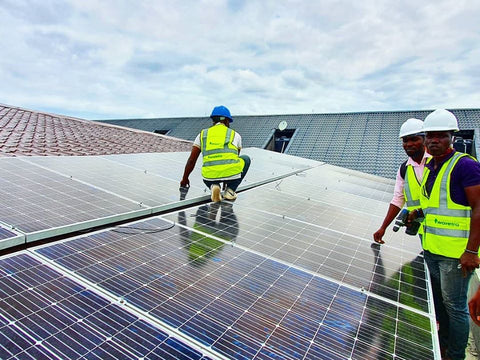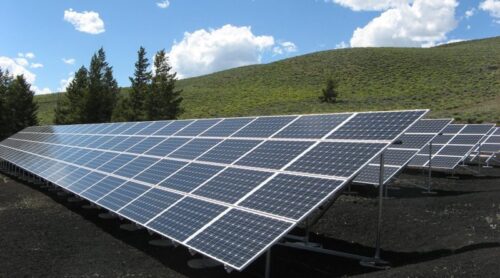
For decades, Nigerian rooftops were covered with satellite dishes and television antennas. Today, a new trend is emerging—rows of solar panels—symbolizing a shift toward alternative energy sources as electricity costs increase.
In 2024, the Nigerian Electricity Regulatory Commission (NERC) implemented a 240% tariff increase for urban consumers. Households classified under Band A—guaranteed 20 hours of daily electricity—now pay ₦209 per kilowatt-hour. For a typical three-person household with essential appliances like air conditioners, refrigerators, and televisions, monthly electricity costs can reach ₦45,000, consuming a significant portion of Nigeria’s new ₦70,000 minimum wage.
Beyond electricity tariffs, fuel prices have also quadrupled, making the financial strain worse. In Lagos’ Akiode community, residents have requested to be downgraded from Band A due to the unsustainable costs. “Previously, five of us shared one meter, contributing ₦10,000 to ₦15,000 per month, which was sufficient. Now, we recharge daily or weekly, sometimes spending ₦10,000 in just one week. That’s money we used to buy food. We can’t afford three meals a day anymore,” a resident lamented.
With electricity costs rising and government subsidies being reduced, solar energy presents a sustainable alternative. However, the major challenge remains the high upfront investment. The major solar solutions include;
Entry-Level Solar Solutions: ₦400,000 – ₦1 Million
A basic solar setup, costing around ₦400,000, provides a modest introduction to solar energy. This system includes an inverter and a 500Wh lithium-iron-phosphate battery but lacks solar panels. It can power essential appliances like a fan, TV, laptop, and mobile phones, but its backup capacity is limited to just 3 to 5 hours.
For ₦1 million, a 1kVA solar system offers improved reliability. This setup includes a 1kWh inverter, a 2.4kWh lithium-iron-phosphate battery, and a 450-watt monocrystalline solar panel. It can support eight lighting points, two fans, a TV, a laptop, and several mobile devices, with a backup time of 6 to 8 hours.

Mid-Range Solar Systems: ₦5 Million
A more robust solution comes at ₦5 million, featuring a 5kVA hybrid solar system with a 5kW hybrid inverter, a 5kWh lithium-iron-phosphate battery, and 4.5kWh mono half-cut solar panels. This setup can accommodate 15 lighting points, two fans, two TVs, a washing machine, an inverter air conditioner, and a fridge. While all appliances cannot operate simultaneously, careful scheduling allows for flexible usage with an 8 to 12-hour backup after sundown.
Social media strategist Agboola Sodiq invested ₦4 million in a 2.5kVA inverter system equipped with six 400W solar panels and a 5.12kWh lithium battery. His setup powers two TVs, two deep freezers, 15 lighting points, multiple laptops, four standing fans, and a washing machine. Before transitioning to solar, Sodiq’s monthly electricity and fuel expenses reached ₦300,000. Now, he spends just ₦30,000 to ₦50,000 on fuel every six months. “Since installing solar, I haven’t used my generator. My annual electricity costs have dropped to ₦40,000, saving me ₦1.72 million in just six months,” he shared.
High-End Solar Systems: ₦10 Million – ₦20 Million
For those requiring more extensive power solutions, a 10kVA hybrid solar system—priced between ₦10 million and ₦20 million—provides full-day electricity. This system includes a 10kWh hybrid inverter, a 10kWh lithium-iron-phosphate battery, and 9kWh solar panels. It supports 25 lighting points, four fans, two TVs, a microwave, and various household appliances, with a 12 to 15-hour backup.
At the highest tier, a ₦20 million 15kVA hybrid solar system offers a nearly off-grid experience. Featuring a 12kW hybrid inverter, 33kWh lithium-iron-phosphate batteries, and 11kWp solar panels, this system powers three inverter air conditioners, three refrigerators, and an extensive array of household devices, ensuring uninterrupted electricity with a 15-hour backup after sundown.
Despite a 20% drop in lithium battery prices globally from 2023 to 2024, Nigeria’s exchange rate fluctuations often negate these savings. However, the increasing availability of solar products offers more options for consumers.
As Rotimi Thomas, CEO of Sunfi, explains, “Despite global solar price reductions, naira fluctuations sometimes offset these benefits. However, the growing variety of solar equipment in Nigeria is expanding affordability options.”
To make solar energy more accessible, flexible financing models—including microloans, pay-as-you-go systems, and partnerships with solar firms—are gaining traction. Additionally, government incentives for renewable energy adoption are under discussion, though implementation has been slow.
As electricity costs continue to climb, more Nigerians are turning to solar power as a long-term solution. While the initial investment is significant, the long-term savings and energy independence make it a compelling choice. With continued advancements in financing and technology, solar energy is poised to become an integral part of Nigeria’s energy future.


